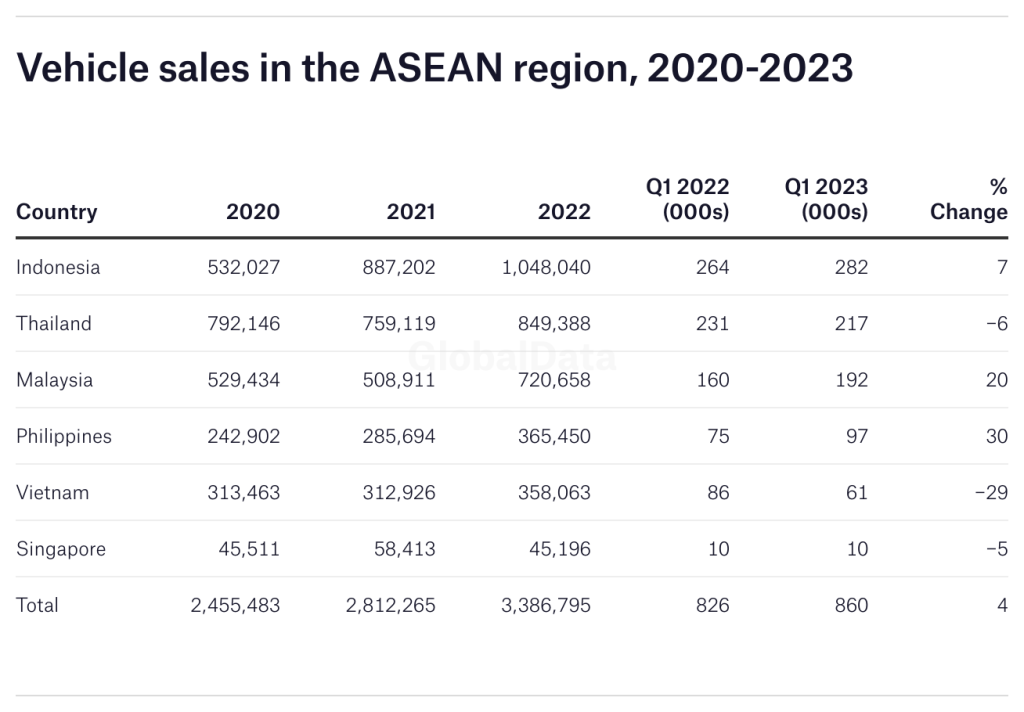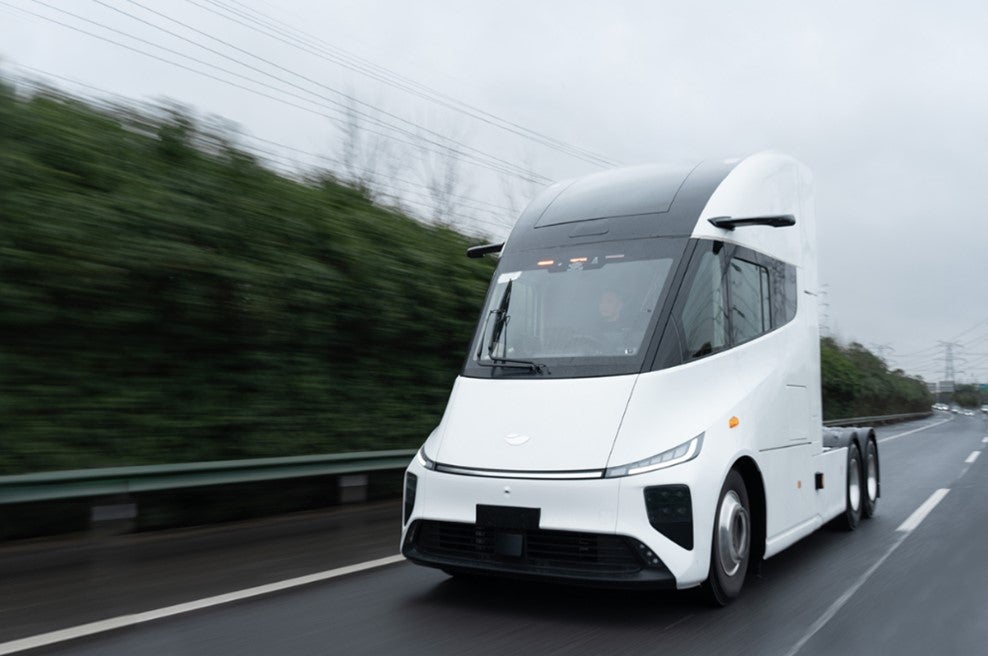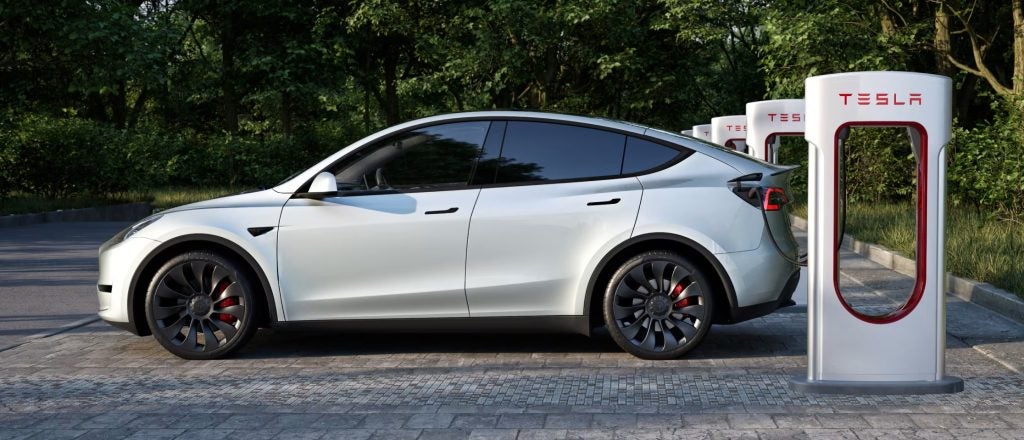
New vehicle sales in the ASEAN region’s six largest markets combined increased by just over 4% year-on-year to 859,655 units in the first quarter of 2023, reversing a slight decline in the fourth quarter of 2022, according to data compiled from the region’s main industry associations and government departments.
First quarter economic growth in much of the ASEAN region was underpinned by a rebound in domestic and international tourism after the Covid lockdowns of the previous two years. This was offset in part by high inflation and rising interest rates which impacted consumer spending, while some countries also struggled with weaker exports and investment.
Overall vehicle sales in the region were helped by improving supplies of semiconductors, which slowed the regional recovery last year. The performances of the individual vehicle markets in the region varied significantly, however, with sales in Thailand and Vietnam falling as consumers struggled most with rising interest rates while economic growth was also held back by declining exports and slower investment.
The Philippines market expanded by over 30% in the first quarter, making it the region’s fastest growing market as the strong rebound from the pandemic lows continued despite surging inflation and significant interest rate hikes over the last year. The Malaysian vehicle market expanded by over 20%, as vehicle manufacturers stepped up deliveries before the expiry of the sales tax exemption at the end of March. Sales in Indonesia continued to grow moderately, with demand driven by recent new models by key brands and higher vehicle output.
The industry remains cautious over the full-year outlook for vehicle sales in most markets in the region, after economic growth likely slowed further in the first quarter as interest rates continued to rise. Slowing global growth will likely impact export activity from the region this year, slowing regional economic growth further.
The Philippines was the fastest growing major market in the ASEAN region in the first quarter, with sales surging by over 30% to 97,284 units according to data released jointly by the Chamber of Automotive Manufacturers of the Philippines Inc (CAMPI) and the Truck Manufacturers Association (TMA). The first-quarter data do not include sales by non-affiliated brands that rely mostly on imports.
How well do you really know your competitors?
Access the most comprehensive Company Profiles on the market, powered by GlobalData. Save hours of research. Gain competitive edge.

Thank you!
Your download email will arrive shortly
Not ready to buy yet? Download a free sample
We are confident about the unique quality of our Company Profiles. However, we want you to make the most beneficial decision for your business, so we offer a free sample that you can download by submitting the below form
By GlobalDataToyota’s sales increased by 21% to 45,205 units year-to-date, while Mitsubishi Motors sales surged by 72% to 17,765 units on strong demand for its Xpander range. Nissan’s sales increased by 8% to 6,396 units, while Ford sold 5,893 units and Honda 4,691 units.
The Philippine economy is estimated to have expanded by over 7% in the first quarter of 2023, driven by strong manufacturing output and infrastructure expenditure. While the central bank has raised its benchmark interest rate from 2.0% to 6.25% in the last year to help curb persistently high inflation, consumer spending has remained strong.
Sales in Vietnam fell by 29% year-on-year to 60,800 units in the first quarter from 85,796 in the same period of last year, according to wholesale data released by the Vietnam Automotive Manufacturers Association (VAMA), after plunging by 35% to 93,112 units in the fourth quarter of last year. The data do not include some key brands such as local start-up VinFast, Mercedes-Benz and passenger vehicles by Hyundai.
The vehicle market is struggling to push on from record highs in the early part of last year, when sales benefited from strong pent-up demand after the Covid lockdowns and lower interest rates. Economic growth in the country continued to slow sharply in the first quarter of 2023, to 3.3% year-on-year after dropping to 5.9% in the previous quarter, compared with 8% growth for the whole of 2022.
Indonesia
New vehicle sales in Indonesia increased by 7% at 282,125 units in the first quarter of 2023 from 263,822 units in the same period of last year, according to wholesale data released by local industry association Gaikindo, with deliveries of passenger and commercial vehicles both up by around 7% at 211,381 and 70,744 units respectively.
The market’s recovery from its 2020 pandemic lows continued last month, albeit at a slowing rate against increasingly strong year-earlier comparisons. The country’s economy has remained buoyant despite fears of a global slowdown, with first-quarter growth expected to have weakened moderately to around 5% – underpinned by a rebound in the tourism sector and strong investment and exports. Bank of Indonesia continued to hike its benchmark interest rate this year in response to rising inflation, to 5.75% from a historic low of 3.50% at the end of 2021.
Toyota’s sales increased by less than 6% to 85,777 units year-to-date, while Daihatsu’s sales were 7% higher at 54,341 units. Honda’s strong recovery continued with sales surging by 33% to 47,027 units – driven by new models including the recent arrival of the new WR-V. Mitsubishi’s sales continued to plunge last month, by almost 35% to 21,942 units after growing strongly last year, while Suzuki’s sales were flat at 22,436 units.
At the beginning of April the Indonesian government lowered the sales tax on battery electric vehicles (BEVs) to 1% from 11% to help drive up sales, which increased to just under 1,800 units in the first quarter compared with 350 units a year earlier. The government is also looking to expand the country’s EV charging network to help achieve its target of two million BEVs in circulation by 2030.
Vehicle production in the country increased by just under 6% to 392,743 units in the first quarter, while exports of built-up vehicles surged by 40% to 133,928 units.
Earlier this year the association said it expected the domestic vehicle market to decline by 7% to around 975,000 units in 2023 from 1.05 million units last year.
Thailand
New vehicle sales in Thailand fell by 6% to 217,076 units in the first quarter of 2023 from 231,189 units a year earlier, according to wholesale data released by the Federation of Thai Industries (FTI) which excludes some key brands including BMW and Mercedes-Benz.
This follows a similar decline in the previous quarter despite improving supplies of semiconductors and the continued normalization of the economy after the Covid pandemic, while the economy also benefited from rebounding domestic and international tourism. Rising interest rates have held back consumer spending this year, while weak exports also put pressure on the economy. First-quarter GDP growth is expected to come in at 2.8%, after dropping to 1.4% in the fourth quarter of 2022, with full-year growth forecast at between 2.7% and 3.7% – driven by a pick-up in domestic consumption in the second half of the year as inflation eases.
Sales of passenger vehicles rose by 8% to 122,812 units year-to-date, while pickup truck sales plunged by 21% to 84,130 units and sales of other vehicles including commercial vehicles fell by 8% to 10,134 units. Vehicle production in the country rose by almost 6% to 507,787 units in the first quarter, driven by a 12% rise in production for export to 288,130 units.
FTI vice-chairman Surapong Paisitpatanapong told local reporters the increase in vehicle output was helped by improving supplies of semiconductors to local automakers. He expects total vehicle production to increase by over 6% to around two million units in 2023 from 1.88 million units last year, including around 1.1 million exports and 900,000 domestic sales. Electric and hybrid vehicle sales combined are forecast to reach 30,000-40,000 units this year, driven by the recent entry of Chinese brands.
Malaysia
New vehicle sales in Malaysia continued to grow strongly in the first quarter of 2023, by just over 20% to 192,474 units from 159,846 units in the same period of last year according to registration data released by the Malaysia Automotive Association (MAA).
This followed growth of 42% last year to a record 720,658 units after two years of decline due to the Covid pandemic. The market this year continued to benefit from improving supplies of semiconductors while vehicle manufacturers rushed to fulfill order backlogs before the end of March deadline for deliveries of vehicles purchased tax-free last year under the government’s Covid recovery stimulus programme.
First quarter sales of passenger vehicle sales surged by over 22% to 171,955 units, while the commercial vehicle segment was up by just under 7% at 20,519 units.
Market leader Perodua, backed by Japan’s Daihatsu Motor, reported a 27% sales increase to 78,564 units year-to-date – underpinned by popular models such as the Bezza, Axia and the recently launched Alza. The company is targeting 314,000 local vehicle sales this year and output of 330,000 units.
Proton’s global sales rebounded by 51% to 40,287 units in the first quarter of 2023 from weak year-earlier volumes, with the Saga its best-selling model with 17,446 sales, followed by the Geely-based X50 compact SUV with 9,668 units.
UMW Toyota reported a 12% sales increase to 25,219 units year-to-date, lifted by the introduction of new models and new variants of exiting models. The company launched the all-new Vios compact sedan last month and plans to launch a second hybrid model in additional to its Corolla Cross and possibly a new BEV later this year.
Economic growth in the country is forecast to slow significantly this year after the 8.7% post-Covid rebound in 2022, with vehicle sales expected to fall from the second quarter onwards. Earlier this year the MAA said it expected the overall vehicle market to decline by 10% to 650,000 units in 2023, reflecting the withdrawal of sales incentives and weaker overall demand.








